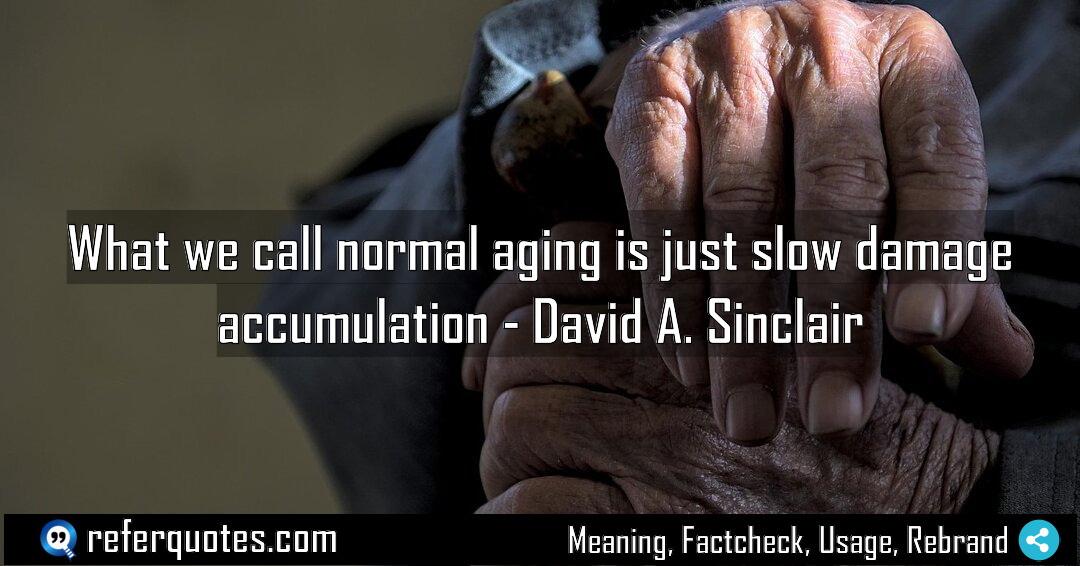
What we call normal aging is just slow damage accumulation. It’s a paradigm-shifting way to view getting older, not as an inevitable decline but as a process we can potentially influence.
Share Image Quote:
Table of Contents
Meaning
At its core, this quote reframes aging. It’s not a mysterious, predetermined program but a physical consequence of wear and tear on our biological systems over time.
Explanation
Okay, so let’s break this down. Think of your body like a brand-new car. When it’s fresh off the lot, everything works perfectly. But as you drive it, things start to happen. The paint gets tiny scratches from dust, the engine accumulates microscopic carbon deposits, the suspension wears down a tiny bit with every bump. That’s the slow damage accumulation. Now, for decades, we’ve looked at an old car—or an older person—and just said, “Well, that’s normal. Things just break down.” But what Sinclair is arguing is that this “normal” state is simply the result of all that accumulated damage. It’s not a separate, magical process. It’s the sum of all the little hits your DNA, your proteins, your cells take from things like sunlight, inflammation, and just the byproducts of metabolism itself. The real kicker, and this is where his work gets exciting, is that if aging is just damage, then in theory, we can find ways to slow down that damage or even repair it. It changes the entire conversation from passive acceptance to active management.
Quote Summary
Reading Level82
Aesthetic Score70
Origin & Factcheck
This quote comes directly from David Sinclair’s 2019 book, “Lifespan: Why We Age—and Why We Don’t Have To,” which was published as he was a professor of genetics at Harvard Medical School in the United States. It’s a central thesis of his work, not a one-off remark, and it’s accurately attributed to him.
Attribution Summary
Where is this quotation located?
| Quotation | What we call normal aging is just slow damage accumulation |
| Book Details | Publication Year: 2019; ISBN: 978-1501191978; Last edition: 2020; Number of pages: 432. |
| Where is it? | Chapter 3: Longevity Now, Approximate page 99 from 2019 edition |
Context
In the book, he uses this idea to introduce his “Information Theory of Aging,” where he posits that the primary damage is the loss of epigenetic information—the cell’s “software” that tells it how to function. The wrinkles, the slower metabolism, the forgetfulness? Those are just the visible outputs of that corrupted data.
Usage Examples
This is a powerful quote to use in a few key situations. First, with clients or audiences in the health and wellness space to shift their mindset from “fighting” aging to “maintaining” their biological hardware. You can say, “We’re not trying to stop time; we’re just doing proactive maintenance to slow the damage accumulation.” Second, it’s great for motivating yourself or a team on a long-term project. “Look, progress feels slow because we’re accumulating small wins, just like aging is slow damage. But each good decision compounds.” And finally, for anyone feeling fatalistic about their health, it’s a reminder that lifestyle choices matter. Every healthy meal, every good night’s sleep, every bout of exercise isn’t just a drop in the bucket—it’s actively countering that daily damage.
To whom it appeals?
Share This Quote Image & Motivate
Motivation Score70
Popularity Score68
Shareability Score70
FAQ
Question: So, does this mean aging is a disease?
Answer: That’s the logical conclusion many, including Sinclair, are leaning towards. If it’s a process of accumulating damage that leads to frailty, disability, and disease, then yes, it can be framed as the ultimate underlying medical condition.
Question: Is all damage accumulation the same for everyone?
Answer: Absolutely not. This is the crucial part. Your genetics load the gun, but your lifestyle and environment pull the trigger. Two people can accumulate damage at wildly different rates based on their diet, stress, exercise, and toxin exposure.
Question: What’s the most significant type of damage according to this view?
Answer: While there are multiple hallmarks of aging, Sinclair’s research focuses heavily on epigenetic noise—the idea that our cells lose their “identity” over time, forgetting whether they’re a skin cell or a brain cell, which leads to dysfunction. It’s a specific type of information damage.
Similar Quotes
What we call aging is actually a series of processes we can reverse. This isn’t just hopeful thinking; it’s the frontier of modern biology, suggesting our cellular fate isn’t sealed.…
You know, I was re-reading David Sinclair’s book the other day, and that line “Aging gracefully is fine, but aging slowly is better” just hits differently the more you sit…
If we can slow aging, we can slow nearly every major disease. It’s a powerful idea that reframes our entire approach to health, suggesting that aging itself is the ultimate…
You know, when David Sinclair says “Aging is a disease, and that disease is treatable,” he’s completely reframing the conversation. It’s not about accepting decline, but about targeting it directly.…
We don’t have to accept aging as inevitable. It’s a radical shift from thinking we’re just passengers on the aging train to realizing we might be the engineers. This quote…
